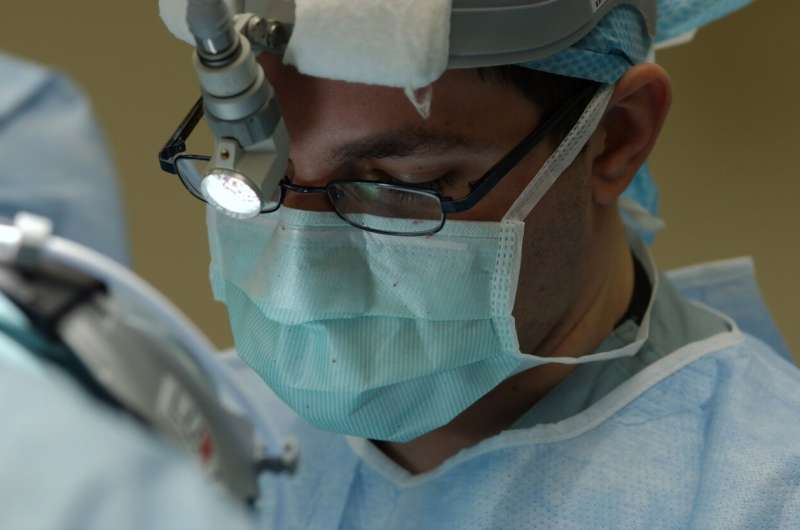This article has been reviewed according to Science X's editorial process and policies. Editors have highlighted the following attributes while ensuring the content's credibility:
fact-checked
peer-reviewed publication
trusted source
proofread
Noninvasive biomarker tests could be alternatives to painful liver biopsies

Led by the director of Virginia Commonwealth University's Stravitz-Sanyal Institute of Liver Disease and Metabolic Health, a consortium studying noninvasive tests for liver disease has demonstrated the effectiveness of five noninvasive tests, a significant milestone on the path to regulatory approval.
In an article published in the journal Nature Medicine, institute director Arun Sanyal, M.D., a professor at the VCU School of Medicine, and colleagues report on five biomarker tests that potentially could be given to patients who may have metabolic dysfunction-associated steatohepatitis, or MASH.
The research to evaluate blood and imaging biomarker tests for liver disease is part of NIMBLE—the Noninvasive Biomarkers of Metabolic Liver Disease project, a public-private partnership involving the Foundation for the National Institutes of Health, the Food and Drug Administration, academic researchers and industry partners. Sanyal, who is the first author of the Nature Medicine paper, chairs the FNIH Biomarkers Consortium NIMBLE program.
Although several companies have developed such tests, none has yet met the requirements needed for FDA regulatory approval.
Finding alternatives to liver biopsy is critical, Sanyal says.
"Currently, diagnosing early-stage MASH requires a liver biopsy, which is a painful, invasive and expensive process for patients. MASH is a serious disease, and once the liver starts to scar up, the risk of cirrhosis, liver cancer and death rises, often leaving transplant the only treatment option for patients," he said.
MASH, formerly known as NASH, is often called a "silent disease," because patients do not display symptoms until later stages of the condition, when they develop cirrhosis. There are no FDA-approved treatments for MASH, which affects about 5% of the U.S. population. About 20% of patients with MASH will progress to cirrhosis, which may require a transplant.
"Dr. Sanyal's leadership of the NIMBLE project has been invaluable as we move toward our goal of fully qualifying noninvasive biomarkers through the FDA," said Tania Kamphaus, Ph.D., a co-author of the paper and FNIH's director of translational science, metabolic disorders as well as patient engagement. "The initial study findings demonstrate that these tests have the potential to enable breakthrough discoveries in developing new treatments for patients with liver disease."
The NIMBLE biomarker tests were compared to standard measures, such as the FIB-4, an index used to gauge liver health developed by Richard Sterling, M.D., clinical director at the liver institute and a professor of medicine in the School of Medicine's division of gastroenterology, hepatology and nutrition and its division of infectious disease. Each biomarker test that met or exceeded the performance of current lab tests was evaluated for use in diagnosing MASH and related conditions among the more than 1,000 patients who participated in the newly published research.
Currently, the only way to test patients for MASH is through liver biopsies, which provide information only from that small section of the 3-pound organ and may not give an accurate overall picture of a patient's disease.
Having accurate biomarker tests for MASH is expected to encourage patients to participate in future clinical trials, which would otherwise require liver biopsies. Using noninvasive blood tests may also significantly reduce costs of such studies, increasing interest in drug development. Equally as important, the tests could be easily ordered in a doctor's office.
"This brings us a step closer to having simple blood-based tests that can be ordered virtually in any clinical setting and will provide access to care to patients," Sanyal said. "Such a step will facilitate our ability to identify those most at risk of outcomes and target them for therapy. It will also serve as a foundation for prognostic, disease monitoring and treatment-response biomarker development."
Sanyal says individuals who are overweight or have type 2 diabetes or high blood pressure should talk with their physician about whether they are at risk of liver disease and what they can do to lower that risk, such as losing weight and taking other measures for a healthier lifestyle.
More information: Diagnostic performance of circulating biomarkers for non-alcoholic steatohepatitis, Nature Medicine (2023). DOI: 10.1038/s41591-023-02539-6




















